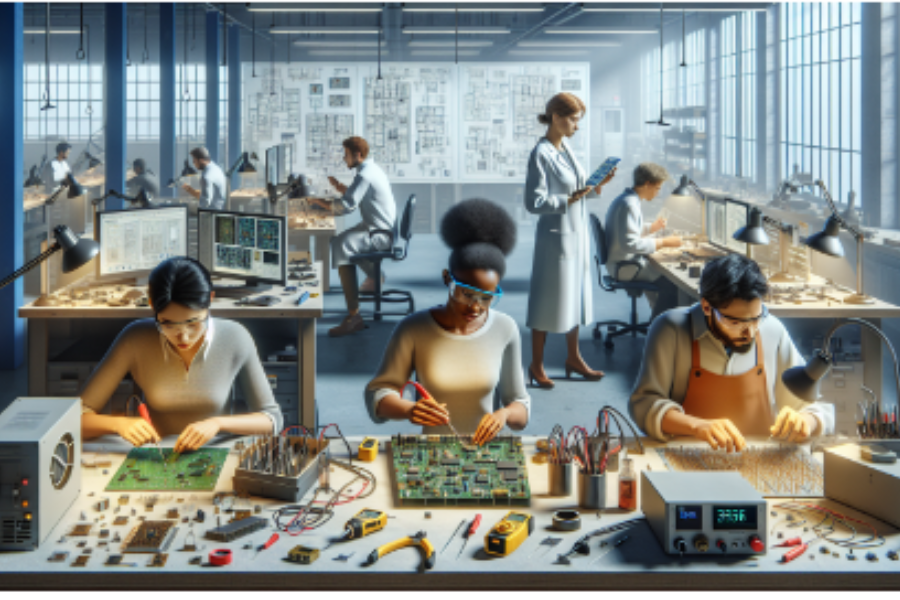The world of electronic product development is constantly evolving, with new technologies and innovations emerging at a rapid pace. As we look towards the future, it’s clear that the industry will continue to undergo significant changes, shaping the way we design, manufacture, and use electronic devices. In this comprehensive article, we’ll explore the key trends and developments that are set to define the future of electronic product development.
The Rise of the Internet of Things (IoT)
Increased Connectivity and Smart Devices
One of the most significant trends in electronic product development is the growing prominence of the Internet of Things (IoT). IoT refers to the interconnectedness of everyday devices and objects through the internet, allowing them to communicate and exchange data seamlessly. As more and more devices become “”smart”” and connected, the demand for IoT-enabled products will continue to soar.
Opportunities for Innovation
The rise of IoT presents countless opportunities for innovation in electronic product development. Developers will need to focus on creating devices that are not only functional but also highly connected and intuitive to use. This will require a deep understanding of user needs and preferences, as well as expertise in areas such as wireless communication protocols, sensor technology, and data analytics.
Advancements in Artificial Intelligence (AI) and Machine Learning (ML)
Smarter and More Adaptive Products
Another key trend shaping the future of electronic product development is the increasing integration of artificial intelligence (AI) and machine learning (ML) capabilities into devices. AI and ML allow products to learn from user behavior and adapt accordingly, providing a more personalized and efficient user experience.
Challenges and Considerations
Developing AI-powered electronic products comes with its own set of challenges and considerations. Developers will need to ensure that their products are not only intelligent but also secure, reliable, and ethically sound. This will require collaboration with experts in fields such as data science, cybersecurity, and ethics to ensure that AI is used responsibly and effectively.
Miniaturization and Wearable Technology
Smaller, Lighter, and More Powerful Devices
The trend towards miniaturization in electronic product development shows no signs of slowing down. As components become smaller and more powerful, developers will be able to create devices that are more compact, lightweight, and versatile than ever before. This will be particularly important in the realm of wearable technology, where comfort and convenience are key.
Innovations in Materials and Manufacturing
To achieve further miniaturization, developers will need to leverage innovations in materials science and manufacturing techniques. This may include the use of advanced materials such as graphene and carbon nanotubes, as well as 3D printing and other additive manufacturing methods that allow for greater design flexibility and customization.
Sustainability and Eco-Friendly Design
Growing Demand for Sustainable Products
As consumers become increasingly environmentally conscious, the demand for sustainable and eco-friendly electronic products will continue to grow. Developers will need to prioritize sustainability throughout the product lifecycle, from the sourcing of materials to the end-of-life disposal of devices.
Strategies for Sustainable Development
To meet this demand, developers will need to adopt a range of strategies for sustainable development. This may include the use of recycled and biodegradable materials, modular design approaches that facilitate repair and upgrades, and energy-efficient technologies that reduce the carbon footprint of devices.
Augmented Reality (AR) and Virtual Reality (VR)
Immersive and Interactive Experiences
Augmented reality (AR) and virtual reality (VR) technologies are set to revolutionize the way we interact with electronic devices. By overlaying digital information onto the real world (AR) or creating entirely virtual environments (VR), these technologies enable highly immersive and interactive experiences that blur the line between the physical and digital worlds.
Applications in Various Industries
The potential applications of AR and VR in electronic product development are vast and varied. From gaming and entertainment to education and training, healthcare and telemedicine, and industrial design and prototyping, these technologies have the potential to transform a wide range of industries.
5G and Beyond: The Future of Wireless Communication
Faster and More Reliable Connectivity
The rollout of 5G networks is set to have a profound impact on electronic product development. With faster speeds, lower latency, and greater bandwidth, 5G will enable a new generation of connected devices and applications that were previously impossible.
Enabling New Use Cases and Innovations
The enhanced capabilities of 5G will open up new possibilities for innovation in electronic product development. From autonomous vehicles and smart cities to remote surgery and industrial automation, 5G will enable a wide range of new use cases that rely on real-time, high-speed connectivity.
Edge Computing and Decentralized Processing
Processing Data Closer to the Source
As the volume of data generated by electronic devices continues to grow, the need for more efficient and decentralized processing solutions becomes increasingly pressing. Edge computing is an approach that involves processing data closer to the source, rather than relying on centralized cloud servers.
Benefits and Challenges
By processing data at the edge, electronic products can achieve faster response times, reduced latency, and improved privacy and security. However, implementing edge computing also comes with its own set of challenges, such as ensuring adequate processing power and storage capacity at the device level.
Cybersecurity and Data Privacy
Protecting Devices and User Data
As electronic products become more connected and data-driven, the need for robust cybersecurity and data privacy measures becomes increasingly critical. Developers will need to prioritize security throughout the product development process, from the initial Custom Circuit Board Design phase to ongoing maintenance and updates.
Balancing Functionality and Security
Striking the right balance between functionality and security will be a key challenge for electronic product developers in the years ahead. This will require close collaboration with security experts and a commitment to staying up-to-date with the latest threats and best practices in cybersecurity.
Collaborative Design and Open-Source Hardware
Fostering Innovation Through Collaboration
The future of electronic product development will be increasingly collaborative, with developers working together across disciplines and organizational boundaries to create innovative new products. Open-source hardware initiatives, which involve sharing hardware designs and specifications freely, will play a key role in fostering this collaborative spirit.
Benefits and Challenges of Open-Source Approach
By embracing open-source hardware, developers can tap into a global community of experts and enthusiasts, accelerating the pace of innovation and reducing development costs. However, this approach also comes with its own set of challenges, such as ensuring the quality and reliability of open-source components and managing intellectual property rights.
Additive Manufacturing and 3D Printing
Rapid Prototyping and Customization
Additive manufacturing techniques such as 3D printing are set to revolutionize electronic product development in the years ahead. By enabling rapid prototyping and customization, these technologies will allow developers to iterate more quickly and respond more effectively to user needs and preferences.
Challenges and Limitations
While additive manufacturing offers many benefits, it also comes with its own set of challenges and limitations. These may include issues related to material properties, surface finish, and overall cost-effectiveness compared to traditional manufacturing methods.
Flexible and Stretchable Electronics
New Possibilities for Wearables and Implantables
Flexible and stretchable electronics represent a new frontier in electronic product development, with the potential to enable a wide range of new applications in areas such as wearables, implantables, and soft robotics. By using materials that can bend, stretch, and conform to complex shapes, developers can create products that are more comfortable, durable, and adaptable than ever before.
Challenges and Opportunities
Developing flexible and stretchable electronics comes with its own set of challenges, such as ensuring adequate conductivity and reliability under strain and stress. However, these challenges also present significant opportunities for innovation and differentiation in the marketplace.
Energy Harvesting and Power Management
Reducing Dependence on Batteries
As electronic devices become more ubiquitous and autonomous, the need for efficient and sustainable power solutions becomes increasingly pressing. Energy harvesting technologies, which involve capturing energy from the environment and converting it into usable electrical power, offer a promising alternative to traditional battery-powered devices.
Challenges and Opportunities
Developing effective energy harvesting solutions requires a deep understanding of the underlying physics and materials science, as well as expertise in power electronics and energy storage. However, the potential benefits are significant, including reduced environmental impact, lower maintenance costs, and improved device reliability.
Human-Centered Design and User Experience
Putting Users at the Center of Product Development
As electronic products become more complex and feature-rich, the need for human-centered design and user experience (UX) becomes increasingly critical. Developers will need to focus on creating products that are not only technically advanced but also intuitive, accessible, and enjoyable to use.
Strategies for Effective User-Centered Design
To achieve effective user-centered design, developers will need to adopt a range of strategies and methodologies, such as user research, usability testing, and iterative design. This will require close collaboration with UX experts and a commitment to ongoing user feedback and refinement.
Stay in touch with us for more updates and alerts! Gossips.Blog




